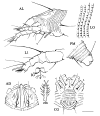Eriophyes pouteriae sp. nov., a New Mite Species Infesting Pouteria sapota
- PMID: 39769574
- PMCID: PMC11679770
- DOI: 10.3390/insects15120972
Eriophyes pouteriae sp. nov., a New Mite Species Infesting Pouteria sapota
Abstract
Pouteria sapota, or "mamey sapote", is a tropical fruit tree native to Central America and Southern Mexico, producing sweet, nutrient and vitamin-rich fruit. Several insect pests are known to infest P. sapota, but none have been associated with plant growth alterations. Eriophyoid mites are well known to cause plant malformations, but mites that cause this type of damage to mamey sapote have not been reported. Trees with abnormal leaf growth, including stunted leaves, outward curling, leaf yellowing, and diminishing overall tree vigor, were found in multiple locations in Southern Florida and one location in Brazil. Numerous plant samples were examined for the presence of minute eriophyoid-like mites, and a new species was found. It was morphologically described, and DNA fragments of the mitochondrial gene cytochrome c oxidase subunit I (COI), the nuclear subunit D2 region in 28S rDNA, and the ITS nuclear regions were PCR-amplified and sequenced. Morphological and molecular descriptions of the new species, named E. pouteriae sp. nov., are provided to aid the identification and future detection of this mite. Even though several species within the genus Eriophyes have been reported on other Sapotaceae species, this is the first eriophyoid mite known to be associated with mamey sapote.
Keywords: Eriophyidae; Eriophyinae; bud mites Eriophyoidea; mamey sapote; molecular markers; morphological description.
Conflict of interest statement
The authors declare no conflicts of interest. The funders had no role in the design of the study; in the collection, analyses, or interpretation of data; in the writing of the manuscript; or in the decision to publish the results.
Figures




References
-
- Campbell R.J., Zill G., Mahdeem H. New mamey sapote cultivars from tropical America. Proc. Interamer. Soc. Trop. Horticul. 1997;41:219–222.
-
- Alia-Tejacal I., Villanueva-Arce R., Pelayo-Zaldívar C., Colinas-León M.T., López-Martínez V., Bautista-Baños S. Postharvest physiology and technology of sapote mamey fruit (Pouteria sapota (Jacq.) HE Moore & Stearn) Postharv. Biol. Technol. 2007;45:285–297. doi: 10.1016/j.postharvbio.2006.12.024. - DOI
-
- Morton J. Sapote. In: Morton J.F., editor. Fruits of Warm Climates. Creative Resources Systems; Miami, FL, USA: 1987. pp. 398–402.
-
- Torres-Rodríguez A., Salinas-Moreno Y., Valle-Guadarrama S., Alia-Tejacol I. Soluble phenols and antioxidant activity in mamey sapote (Pouteria sapota) fruits in postharvest. Food Res. Int. 2011;44:1956–1961. doi: 10.1016/j.foodres.2011.04.045. - DOI
-
- Carriço C., Pinto Z.T., Dutok C.M.S., Reyes-Tur B., Queiro M.M.C. Biological activity of Pouteria sapota leaf extract on postembryonic development of blowfly Chrysomya putoria (Wiedemann, 1818) (Calliphoridae) Rev. Brasil. Farm. 2014;24:304–308. doi: 10.1016/j.bjp.2014.07.007. - DOI
Grants and funding
LinkOut - more resources
Full Text Sources

